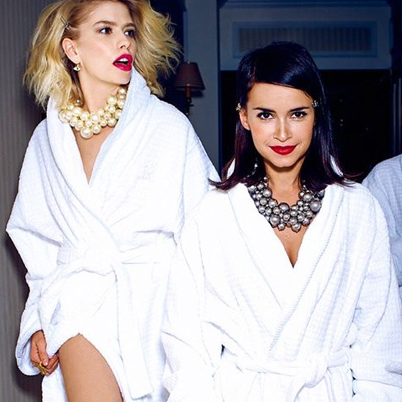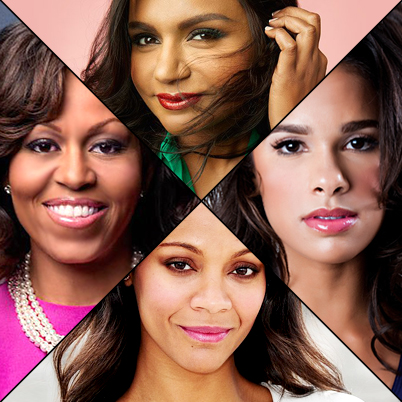Ayurvedic beauty rule No. 1: Get out of bed with the sun. Ripping the covers off at the crack of dawn may seem bad for a fresh-faced glow, but according to Ayurvedic principles, to look and feel great all day, our routine must be in sync with nature. To that end, bedtime should be no later than 10 p.m. or 11 p.m., says Rai.
Because sleep is a time when the body repairs itself and digestion shuts down, make lunch your biggest meal of the day. "If you eat a big meal before sleeping, your body doesn't digest it properly," says Rai.
The not-so-pretty result: a buildup of toxins in the body. "What we call ama," says Rai. Ama shows up as dull skin and a white coating on the tongue, which Rai says you should remove daily with a tongue scraper.
Because sleep is a time when the body repairs itself and digestion shuts down, make lunch your biggest meal of the day. "If you eat a big meal before sleeping, your body doesn't digest it properly," says Rai.
The not-so-pretty result: a buildup of toxins in the body. "What we call ama," says Rai. Ama shows up as dull skin and a white coating on the tongue, which Rai says you should remove daily with a tongue scraper.
"I dry brush every single day," says Ayurvedic practitioner Denise Baron. "When the lymphatic system, which is the garbage remover of your body, is clogged, it's like a road block," she says.
Dry brushing your body will increase circulation, calm your nervous system and help a sluggish lymphatic system get moving.
What that means for your exterior: major glow-inducing exfoliation and skin-toning (buh-bye, cellulite) that celebrities like Elle Macpherson, Molly Sims and Miranda Kerr all swear by. And we thought they were just blessed with perfect genes.
Baron recommends using a garshan glove for dry brushing. Made of raw silk, the gloves are a slightly gentler alternative to stiff brushes that might cause irritation to skin.
See our step-by-step guide to dry brushing here.
Dry brushing your body will increase circulation, calm your nervous system and help a sluggish lymphatic system get moving.
What that means for your exterior: major glow-inducing exfoliation and skin-toning (buh-bye, cellulite) that celebrities like Elle Macpherson, Molly Sims and Miranda Kerr all swear by. And we thought they were just blessed with perfect genes.
Baron recommends using a garshan glove for dry brushing. Made of raw silk, the gloves are a slightly gentler alternative to stiff brushes that might cause irritation to skin.
See our step-by-step guide to dry brushing here.
Have you heard of ghee? Touted as a superfood, it has one very distinguishing characteristic: It's full of fat. The paleo-approved clarified butter is a staple in Ayurvedic medicine. Ayurvedic practitioners use it as a carrier oil when mixing up skin-healing tonics and massage oils, and as a once-daily supplement -- kind of like a buttery, liquid vitamin that detoxifies your system.
It's also great for the eyes. Baron says that because the eyes hold so much tension, it's important to keep them well lubricated. A ghee bath stimulates hydration in the eyes and can help reduce redness. "It also gives the eyes luster and softens wrinkles around your orbital bone," says Baron.
But don't head off to your fridge just yet. This is not something you should DIY at home, says Baron. Because it involves creating a dam-like bath for the ghee to sit in, trying to do it yourself (with your eyes closed) will stimulate more stress than relaxation. Instead, visit an Ayurvedic practitioner for a ghee bath, also known as netra basti eye therapy.
It's also great for the eyes. Baron says that because the eyes hold so much tension, it's important to keep them well lubricated. A ghee bath stimulates hydration in the eyes and can help reduce redness. "It also gives the eyes luster and softens wrinkles around your orbital bone," says Baron.
But don't head off to your fridge just yet. This is not something you should DIY at home, says Baron. Because it involves creating a dam-like bath for the ghee to sit in, trying to do it yourself (with your eyes closed) will stimulate more stress than relaxation. Instead, visit an Ayurvedic practitioner for a ghee bath, also known as netra basti eye therapy.
Before diving into an Ayurvedic practice, you first need to know your dosha, -- a mix of physical and emotional qualities that make you you. There are three types: Pitta, Vata and Kapha.
Kind of like a "Which 'Sex in the City' Character Are You?" quiz, most people don't fall under just one type. You may be 80 percent Charlotte with a sprinkle of Miranda and Carrie thrown in.
Those who are Pittas, the fire dosha, tend to be intelligent, passionate, fiery and competitive, and when they become unbalanced, that usually shows up as inflammation and acne. The Vata types are usually thin, lively and always on the move, which can translate to anxiety, insomnia and dry skin. Kaphas are grounded people who are strong, stable and muscular, which means they're also prone to sluggishness, weight gain and holding grudges when their dosha is out of whack.
Shadoh Punnapuzha, owner of Arya Essentials, says that an Ayurvedic practitioner will look at your pulse, skin, hair, nails, eyeballs and tongue to get an idea of what your dosha is and what might be out of whack. When your dosha is out of balance, it shows up physically and mentally. But when it's brought into balance, says Punnapuzha, it will show. "These are not overnight results, because Ayurveda is not as aggressive as Western medicine, but the results will make you smile. Your skin will have a natural glow, you will look younger and there is a freshness to you," she explains.
Kind of like a "Which 'Sex in the City' Character Are You?" quiz, most people don't fall under just one type. You may be 80 percent Charlotte with a sprinkle of Miranda and Carrie thrown in.
Those who are Pittas, the fire dosha, tend to be intelligent, passionate, fiery and competitive, and when they become unbalanced, that usually shows up as inflammation and acne. The Vata types are usually thin, lively and always on the move, which can translate to anxiety, insomnia and dry skin. Kaphas are grounded people who are strong, stable and muscular, which means they're also prone to sluggishness, weight gain and holding grudges when their dosha is out of whack.
Shadoh Punnapuzha, owner of Arya Essentials, says that an Ayurvedic practitioner will look at your pulse, skin, hair, nails, eyeballs and tongue to get an idea of what your dosha is and what might be out of whack. When your dosha is out of balance, it shows up physically and mentally. But when it's brought into balance, says Punnapuzha, it will show. "These are not overnight results, because Ayurveda is not as aggressive as Western medicine, but the results will make you smile. Your skin will have a natural glow, you will look younger and there is a freshness to you," she explains.
Abhyanga, or self-massage, is a daily Ayurvedic ritual that involves massaging the skin for about 15 minutes with warm oil. According to Baron, this calms the nervous system and promotes relaxation. "Skin responds to touch, and self-massage promotes the formation of oxytocin, the feel-good hormone," says Baron. Oxytocin is considered an anti-aging, anti-inflammatory hormone that makes skin look more youthful and radiant. One pilot study found that Abhyanga significantly reduced stress levels.
To get the time-reversing benefits of Abhyanga, set aside 15-20 minutes in the morning or evening, right before you take your shower or bath. You can use any warm oil (Neka Pasquale, founder of Urban Remedy, says that castor oil is a versatile healing oil that is good for pain relief, eczema and psoriasis that anyone can use), but Ayurvedic practitioners also recommend choosing an oil based on your dosha type.
Vatas should reach for a relaxing oil, like sesame or almond. Pittas should use a soothing oil, like coconut or sunflower. Kaphas should try something invigorating, like safflower.
Warm about 1/4 cup of oil to a comfortably warm temperature. (Massage therapists recommend bringing a pot of water to boil, then setting a mug of oil in the pot for a minute or two.) Begin by applying the oil at the crown of your head, then work your way out in circular strokes. On your face, massage in tiny circles, always moving in an upward motion. On your body, use long, sweeping strokes toward your heart. Massage the abdomen and chest in clockwise, circular motions. End by spending a few minutes on your feet.
Allow the oil to sink in for about five minutes, then take a warm bath or shower. Blot -- don't rub -- yourself dry with a towel.
To get the time-reversing benefits of Abhyanga, set aside 15-20 minutes in the morning or evening, right before you take your shower or bath. You can use any warm oil (Neka Pasquale, founder of Urban Remedy, says that castor oil is a versatile healing oil that is good for pain relief, eczema and psoriasis that anyone can use), but Ayurvedic practitioners also recommend choosing an oil based on your dosha type.
Vatas should reach for a relaxing oil, like sesame or almond. Pittas should use a soothing oil, like coconut or sunflower. Kaphas should try something invigorating, like safflower.
Warm about 1/4 cup of oil to a comfortably warm temperature. (Massage therapists recommend bringing a pot of water to boil, then setting a mug of oil in the pot for a minute or two.) Begin by applying the oil at the crown of your head, then work your way out in circular strokes. On your face, massage in tiny circles, always moving in an upward motion. On your body, use long, sweeping strokes toward your heart. Massage the abdomen and chest in clockwise, circular motions. End by spending a few minutes on your feet.
Allow the oil to sink in for about five minutes, then take a warm bath or shower. Blot -- don't rub -- yourself dry with a towel.






